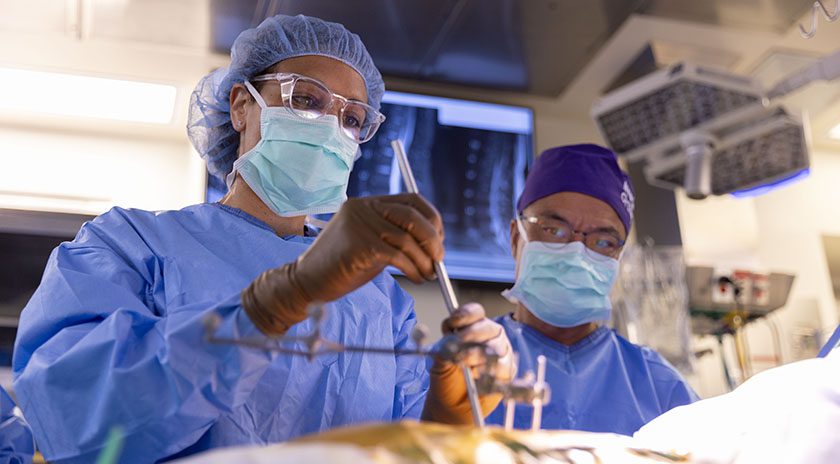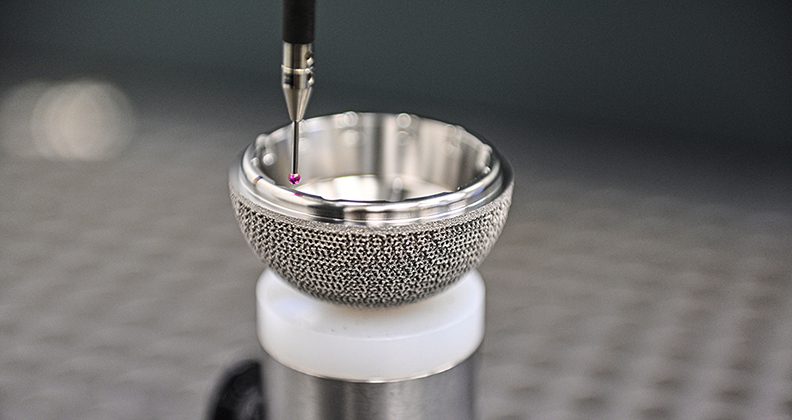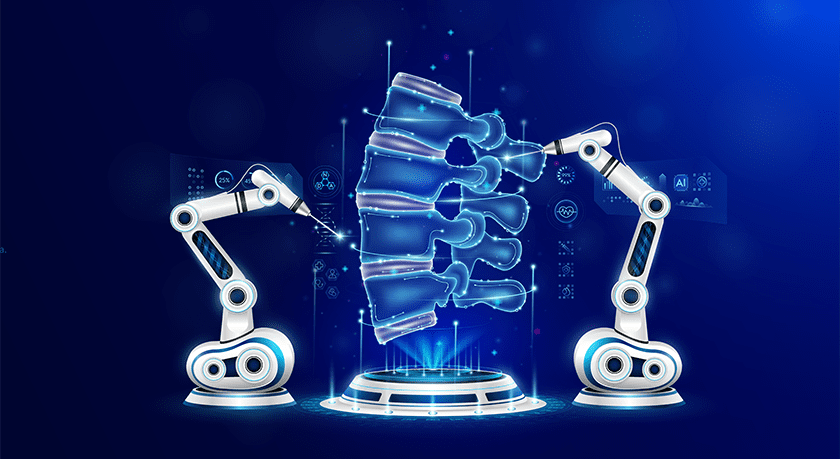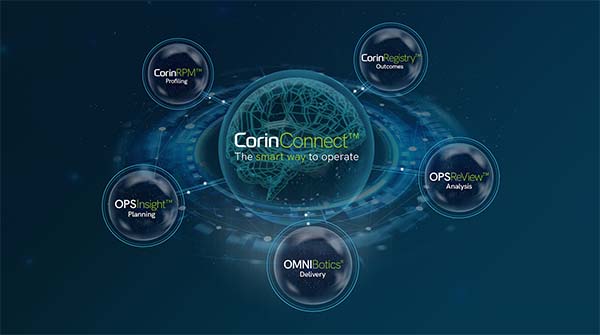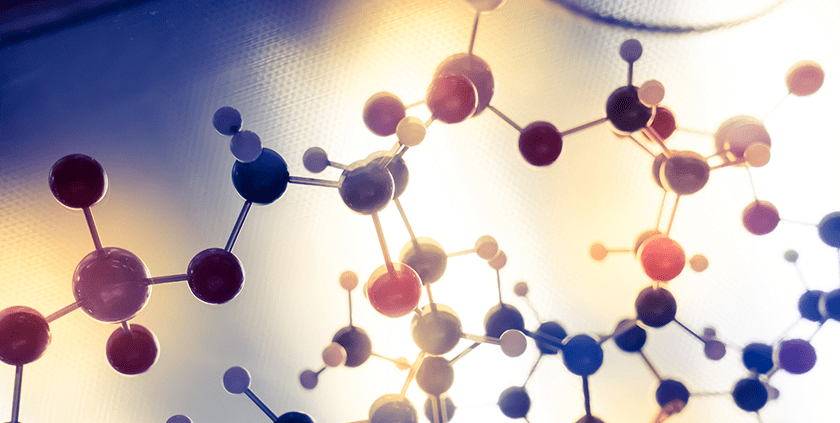

 Copy to clipboard
Copy to clipboard 
At AAOS, we sat down with the CEOs of Bioventus and Histogenics to ask about the opportunities that their companies are embracing, as well as the health of the orthobiologics market.
During the interviews, we noted that we identified six orthobiologic companies as first-time exhibitors and significant education dedicated to research and trends in the space. We wanted to know what was driving our perceived uptick in conversation around orthobiologics. Both CEOs mentioned advancements in therapies demonstrated through clinical trials and outcomes and both discussed the importance of keeping younger, active patients healthy and mobile.
Here we recap a portion of those conversations.
BIOVENTUS
Anthony P. Bihl III, Chief Executive Officer
Since it was spun from Smith & Nephew in 2012, Bioventus has been active in acquisitions and distribution and product development collaborations. The company’s revenue is split about 60% orthobiologics, 40% bone stimulation, with its hyaluronic acid (HA) products growing the fastest.
Durolane: Hyaluronic Acid
In 1Q18, Bioventus commenced the U.S. launch of Durolane, a HA product for treatment of joint pain associated with knee osteoarthritis. Bioventus is now the only company to offer one, three and five injection HA products in the U.S. Durolane has been sold ex-U.S. for knee and hip pain for nearly 15 years. Bioventus approached FDA with its ex-U.S. data and the message of its safety and effectiveness for more than a decade, which led to the company receiving rapid premarket approval, Bihl said.
Bioventus now has the competitive advantage of having a complete HA line. The HA market is 40% single-injection, 42% three-injection and the remainder five-injection, Bihl noted.
“The single-injection market is growing the fastest,” Bihl said. “You might imagine that the five-injection market would go away, but it’s been amazingly sticky. It’s gone away a couple percent a year, but people thought it would go by the wayside and it has not. For us, it’s a major revenue source.”
Cartilage Replacement
Bioventus invested $2.5 million in CartiHeal’s ongoing clinical study for Agili-C, an implant for the treatment of joint surface lesions. The Investigational Device Exemption trial kicked off in 4Q17 and will enroll a minimum of 250 patients with the objective to demonstrate superiority of Agili-C vs. microfracture to treat cartilage or osteochondral defects.
“The whole market is looking at cartilage replacement,” Bihl said, noting that the data is lacking. “There are a number of technologies out there in clinical studies. …We put money into [CartiHeal] because we think [Agili-C] is good enough that we want to be part of it, but not good enough that we want to own the thing—and they aren’t interested, either. The point I want to make is it’s a developing market, and we’re starting to see enough products that have some data that shows that biologics are going to grow. It’s a very important market. What we love about it is we’re working with solutions that activate the body’s natural healing.”
Bihl was firm that Bioventus will continue to invest in orthobiologics, including the company’s own R&D and collaborations with other companies. HA, synthetics and cartilage regeneration are areas of high interest for Bioventus. In 1Q18, the company launched Durolane, invested in CartiHeal’s study, extended its SUPARTZ FX distribution agreement with Seikagaku and entered into an agreement with LifeLink to co-develop bone allograft for spine and trauma applications.
“When we were formed from the spinout of Smith & Nephew, our private equity investors made a commitment to invest to build a portfolio,” Bihl said. “What we find is that there are a number of companies that have a product, but don’t have [surgeon] access like us. One of the attractions about us is that we are private equity owned, so we have money and can make investments, but we’re not big like Medtronic where we can write big checks, so we partner with people and create collaborative relationships.”
HISTOGENICS
Adam Gridley, President and Chief Executive Officer
Since its founding in 2000, Histogenics has focused on treatment for articular cartilage lesions in the knees of healthy, active adults, through its NeoCart implant. Histogenics expects to report top-line one-year superiority data for its NeoCart Phase III clinical trial in 3Q18, followed by a Biologics License Application and potential approval and 2H19 market launch in the U.S.
The company is building its manufacturing capabilities and sales force while awaiting final data on its trial. As the company moves closer to market launch after more than a decade of research and development, we asked what comes next? Gridley spoke about expanding indications and geographies.
Ex-U.S. Expansion
In 1Q18, Histogenics signed an agreement with Japanese-based MEDINET to develop and commercialize NeoCart cell therapy. Commercialization could commence in 2021, following a successful clinical trial in Japan, submission of its Phase III clinical trial data and approval of its Marketing and Manufacturing Authorization.
Beyond Japan, Gridley said Histogenics is looking at South Korea and China for commercialization—Korea because of its well-established regulatory process and China because of the market size and a greater cultural desire for personalized cell therapy.
“Our Phase III trial is one of the largest prospective trials ever done in the U.S., Canada and Europe,” Gridley said. In response to a question about attractiveness of ex-U.S. markets, he added that the company is considering, “one, how do we leverage existing data from this trial that has taken a really long time to enroll and cost a lot of money, but we think is going to be one of the new gold standards in clinical trials. Two, what does the patient need? What we’ve heard in Asia and Japan is that there are no opioids, so people are living in a lot of pain. You don’t have the opioid crisis, but you have patients who are looking for rapid pain relief. When we talk to surgeons, they say, ‘We really need a product like [NeoCart].’ ”
Platform Technology
Histogenics’ current focus is on knee cartilage. The company believes that it can easily target ankle, hip and shoulder as future indications. All of Histogenics’ manufacturing capabilities are in-house. From a manufacturing standpoint, the company would change the size of the implanted scaffold to fit the anatomical region, but the manufacturing process wouldn’t change.
Gridley believes that the company could enter a later stage trial quickly to substantiate indications for additional regulatory approval.
Further, NeoCart is an autologous cell therapy. Reimbursement is expected to be about $40,000. With an anticipated increase in consumer demand for these types of implants, how can companies like Histogenics decrease the cost of the orthobiologic therapies?
Gridley said that looking out 10 to 15 years, the company is considering how to create a master cell bank that houses off-the-shelf, inexpensive therapies.
“Over the next five years, the autologous therapies will work great—they’re safe, they’re patients’ own cells—but there are advances in allogenic cell sources where you can print sheets of these cells and bring the cost down further.”
Gridley pointed out that Histogenics is not the only company interested in this market, both on the commercial and the patient sides.
“There is going to be a real consumer driven expansion of the market—that’s important for people to take away. A lot of people see this as a zero-sum game when looking at the number of competitors coming on the market. But then you look at the sheer size of all the patients—healthy, active adults—who get hurt and don’t treat it because there aren’t therapies, and then they get osteoarthritis. Our hope is that as consumers become more educated, they’ll have more choices.”
Carolyn LaWell is Chief Content Officer for ORTHOWORLD. Reach her by email.
At AAOS, we sat down with the CEOs of Bioventus and Histogenics to ask about the opportunities that their companies are embracing, as well as the health of the orthobiologics market.
During the interviews, we noted that we identified six orthobiologic companies as first-time exhibitors and significant education dedicated to research and trends...
At AAOS, we sat down with the CEOs of Bioventus and Histogenics to ask about the opportunities that their companies are embracing, as well as the health of the orthobiologics market.
During the interviews, we noted that we identified six orthobiologic companies as first-time exhibitors and significant education dedicated to research and trends in the space. We wanted to know what was driving our perceived uptick in conversation around orthobiologics. Both CEOs mentioned advancements in therapies demonstrated through clinical trials and outcomes and both discussed the importance of keeping younger, active patients healthy and mobile.
Here we recap a portion of those conversations.
BIOVENTUS
Anthony P. Bihl III, Chief Executive Officer
Since it was spun from Smith & Nephew in 2012, Bioventus has been active in acquisitions and distribution and product development collaborations. The company’s revenue is split about 60% orthobiologics, 40% bone stimulation, with its hyaluronic acid (HA) products growing the fastest.
Durolane: Hyaluronic Acid
In 1Q18, Bioventus commenced the U.S. launch of Durolane, a HA product for treatment of joint pain associated with knee osteoarthritis. Bioventus is now the only company to offer one, three and five injection HA products in the U.S. Durolane has been sold ex-U.S. for knee and hip pain for nearly 15 years. Bioventus approached FDA with its ex-U.S. data and the message of its safety and effectiveness for more than a decade, which led to the company receiving rapid premarket approval, Bihl said.
Bioventus now has the competitive advantage of having a complete HA line. The HA market is 40% single-injection, 42% three-injection and the remainder five-injection, Bihl noted.
“The single-injection market is growing the fastest,” Bihl said. “You might imagine that the five-injection market would go away, but it’s been amazingly sticky. It’s gone away a couple percent a year, but people thought it would go by the wayside and it has not. For us, it’s a major revenue source.”
Cartilage Replacement
Bioventus invested $2.5 million in CartiHeal’s ongoing clinical study for Agili-C, an implant for the treatment of joint surface lesions. The Investigational Device Exemption trial kicked off in 4Q17 and will enroll a minimum of 250 patients with the objective to demonstrate superiority of Agili-C vs. microfracture to treat cartilage or osteochondral defects.
“The whole market is looking at cartilage replacement,” Bihl said, noting that the data is lacking. “There are a number of technologies out there in clinical studies. …We put money into [CartiHeal] because we think [Agili-C] is good enough that we want to be part of it, but not good enough that we want to own the thing—and they aren’t interested, either. The point I want to make is it’s a developing market, and we’re starting to see enough products that have some data that shows that biologics are going to grow. It’s a very important market. What we love about it is we’re working with solutions that activate the body’s natural healing.”
Bihl was firm that Bioventus will continue to invest in orthobiologics, including the company’s own R&D and collaborations with other companies. HA, synthetics and cartilage regeneration are areas of high interest for Bioventus. In 1Q18, the company launched Durolane, invested in CartiHeal’s study, extended its SUPARTZ FX distribution agreement with Seikagaku and entered into an agreement with LifeLink to co-develop bone allograft for spine and trauma applications.
“When we were formed from the spinout of Smith & Nephew, our private equity investors made a commitment to invest to build a portfolio,” Bihl said. “What we find is that there are a number of companies that have a product, but don’t have [surgeon] access like us. One of the attractions about us is that we are private equity owned, so we have money and can make investments, but we’re not big like Medtronic where we can write big checks, so we partner with people and create collaborative relationships.”
HISTOGENICS
Adam Gridley, President and Chief Executive Officer
Since its founding in 2000, Histogenics has focused on treatment for articular cartilage lesions in the knees of healthy, active adults, through its NeoCart implant. Histogenics expects to report top-line one-year superiority data for its NeoCart Phase III clinical trial in 3Q18, followed by a Biologics License Application and potential approval and 2H19 market launch in the U.S.
The company is building its manufacturing capabilities and sales force while awaiting final data on its trial. As the company moves closer to market launch after more than a decade of research and development, we asked what comes next? Gridley spoke about expanding indications and geographies.
Ex-U.S. Expansion
In 1Q18, Histogenics signed an agreement with Japanese-based MEDINET to develop and commercialize NeoCart cell therapy. Commercialization could commence in 2021, following a successful clinical trial in Japan, submission of its Phase III clinical trial data and approval of its Marketing and Manufacturing Authorization.
Beyond Japan, Gridley said Histogenics is looking at South Korea and China for commercialization—Korea because of its well-established regulatory process and China because of the market size and a greater cultural desire for personalized cell therapy.
“Our Phase III trial is one of the largest prospective trials ever done in the U.S., Canada and Europe,” Gridley said. In response to a question about attractiveness of ex-U.S. markets, he added that the company is considering, “one, how do we leverage existing data from this trial that has taken a really long time to enroll and cost a lot of money, but we think is going to be one of the new gold standards in clinical trials. Two, what does the patient need? What we’ve heard in Asia and Japan is that there are no opioids, so people are living in a lot of pain. You don’t have the opioid crisis, but you have patients who are looking for rapid pain relief. When we talk to surgeons, they say, ‘We really need a product like [NeoCart].’ ”
Platform Technology
Histogenics’ current focus is on knee cartilage. The company believes that it can easily target ankle, hip and shoulder as future indications. All of Histogenics’ manufacturing capabilities are in-house. From a manufacturing standpoint, the company would change the size of the implanted scaffold to fit the anatomical region, but the manufacturing process wouldn’t change.
Gridley believes that the company could enter a later stage trial quickly to substantiate indications for additional regulatory approval.
Further, NeoCart is an autologous cell therapy. Reimbursement is expected to be about $40,000. With an anticipated increase in consumer demand for these types of implants, how can companies like Histogenics decrease the cost of the orthobiologic therapies?
Gridley said that looking out 10 to 15 years, the company is considering how to create a master cell bank that houses off-the-shelf, inexpensive therapies.
“Over the next five years, the autologous therapies will work great—they’re safe, they’re patients’ own cells—but there are advances in allogenic cell sources where you can print sheets of these cells and bring the cost down further.”
Gridley pointed out that Histogenics is not the only company interested in this market, both on the commercial and the patient sides.
“There is going to be a real consumer driven expansion of the market—that’s important for people to take away. A lot of people see this as a zero-sum game when looking at the number of competitors coming on the market. But then you look at the sheer size of all the patients—healthy, active adults—who get hurt and don’t treat it because there aren’t therapies, and then they get osteoarthritis. Our hope is that as consumers become more educated, they’ll have more choices.”
Carolyn LaWell is Chief Content Officer for ORTHOWORLD. Reach her by email.

You are out of free articles for this month
Subscribe as a Guest for $0 and unlock a total of 5 articles per month.
You are out of five articles for this month
Subscribe as an Executive Member for access to unlimited articles, THE ORTHOPAEDIC INDUSTRY ANNUAL REPORT and more.
CL
Carolyn LaWell is ORTHOWORLD's Chief Content Officer. She joined ORTHOWORLD in 2012 to oversee its editorial and industry education. She previously served in editor roles at B2B magazines and newspapers.


